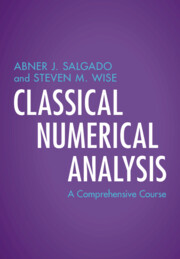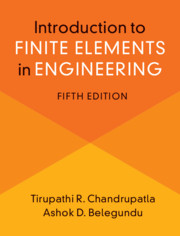Refine search
Actions for selected content:
1945 results in Engineering mathematics and programming
29 - Finite Difference Methods for Hyperbolic Problems
- from Part V - Boundary and Initial Boundary Value Problems
-
- Book:
- Classical Numerical Analysis
- Published online:
- 29 September 2022
- Print publication:
- 20 October 2022, pp 811-836
-
- Chapter
- Export citation
Symbols
-
- Book:
- Classical Numerical Analysis
- Published online:
- 29 September 2022
- Print publication:
- 20 October 2022, pp xix-xxiv
-
- Chapter
- Export citation
12 - Fourier Series
- from Part II - Constructive Approximation Theory
-
- Book:
- Classical Numerical Analysis
- Published online:
- 29 September 2022
- Print publication:
- 20 October 2022, pp 320-344
-
- Chapter
- Export citation
Acknowledgements
-
- Book:
- Classical Numerical Analysis
- Published online:
- 29 September 2022
- Print publication:
- 20 October 2022, pp xvii-xviii
-
- Chapter
- Export citation

Classical Numerical Analysis
- A Comprehensive Course
-
- Published online:
- 29 September 2022
- Print publication:
- 20 October 2022

Introduction to Finite Elements in Engineering
-
- Published online:
- 08 November 2021
- Print publication:
- 21 October 2021
-
- Textbook
- Export citation
10 - Structural Vibration
-
- Book:
- Introduction to Finite Elements in Engineering
- Published online:
- 08 November 2021
- Print publication:
- 21 October 2021, pp 384-443
-
- Chapter
- Export citation
Detailed Contents
-
- Book:
- Introduction to Finite Elements in Engineering
- Published online:
- 08 November 2021
- Print publication:
- 21 October 2021, pp ix-xviii
-
- Chapter
- Export citation
9 - Elements in Bending
-
- Book:
- Introduction to Finite Elements in Engineering
- Published online:
- 08 November 2021
- Print publication:
- 21 October 2021, pp 340-383
-
- Chapter
- Export citation
12 - Preprocessing and Postprocessing
-
- Book:
- Introduction to Finite Elements in Engineering
- Published online:
- 08 November 2021
- Print publication:
- 21 October 2021, pp 468-488
-
- Chapter
- Export citation
Contents
-
- Book:
- Introduction to Finite Elements in Engineering
- Published online:
- 08 November 2021
- Print publication:
- 21 October 2021, pp vii-viii
-
- Chapter
- Export citation
Bibliography
-
- Book:
- Introduction to Finite Elements in Engineering
- Published online:
- 08 November 2021
- Print publication:
- 21 October 2021, pp 490-492
-
- Chapter
- Export citation
8 - Two- and Three-Dimensional Heat Conduction and Other Scalar Field Problems
-
- Book:
- Introduction to Finite Elements in Engineering
- Published online:
- 08 November 2021
- Print publication:
- 21 October 2021, pp 293-339
-
- Chapter
- Export citation
Frontmatter
-
- Book:
- Introduction to Finite Elements in Engineering
- Published online:
- 08 November 2021
- Print publication:
- 21 October 2021, pp i-iv
-
- Chapter
- Export citation
1 - Energy and Galerkin Approaches
-
- Book:
- Introduction to Finite Elements in Engineering
- Published online:
- 08 November 2021
- Print publication:
- 21 October 2021, pp 1-34
-
- Chapter
- Export citation
6 - Two- and Three-Dimensional Elasticity
-
- Book:
- Introduction to Finite Elements in Engineering
- Published online:
- 08 November 2021
- Print publication:
- 21 October 2021, pp 183-258
-
- Chapter
- Export citation
11 - Miscellaneous Topics
-
- Book:
- Introduction to Finite Elements in Engineering
- Published online:
- 08 November 2021
- Print publication:
- 21 October 2021, pp 444-467
-
- Chapter
- Export citation
Index
-
- Book:
- Introduction to Finite Elements in Engineering
- Published online:
- 08 November 2021
- Print publication:
- 21 October 2021, pp 493-494
-
- Chapter
- Export citation
List of Symbols and Computer Code Variables
-
- Book:
- Introduction to Finite Elements in Engineering
- Published online:
- 08 November 2021
- Print publication:
- 21 October 2021, pp 489-489
-
- Chapter
- Export citation
Preface
-
- Book:
- Introduction to Finite Elements in Engineering
- Published online:
- 08 November 2021
- Print publication:
- 21 October 2021, pp xix-xxiv
-
- Chapter
- Export citation
